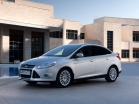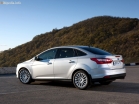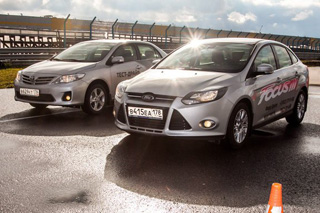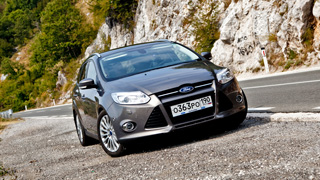Test drive Ford Focus sedan since 2010 sedan
The facets of the beautiful
 What is Ford Focus, no need to explain to anyone the model managed to become a truly folk
What is Ford Focus, no need to explain to anyone the model managed to become a truly folk But what does the first -generation Focus turn into after several years of operation and what should buyers of used cars be ready for?
For the first time, Focus was represented by the general public in 1998, but in Russia the model became popular only in the XXI century in 2002 Focus began to gather in the city of Vsevolozhsk, the Leningrad Region (now the second generation of Focus is being made there). Of course, one of the most important topics when discussing Focus used by Focus. Like, the car assembled in Russia cannot be of high quality. By definition. However, operating experience suggests that I should not be afraid of Vsevolozhskiy machines. After all, there are very few domestic components there. In addition, do not forget that cars made in Russia are adapted to our roads. So, they have as much as 17 mm higher the road clearance, it is 170 mm (you must admit, the extra millimeters of the clearance are never superfluous).
But I would be worried about cars from the United States. There are more than enough of them in the secondary market, because Focus was sold not only in Europe, but also in America. Moreover, in the States, the car was very inexpensive, moreover, over time, it was noticeably falling in price. This is what makes such cars into our country a very attractive occupation.
The insides of the first generation Focus look very original. And not everyone can like it. Over time, the upholstery in the cabin is greasy, but if the previous owners were not dirty, then even the cars of the first years of production look quite decent. The air conditioning and electric drives of glasses and mirrors work without complaints, although by now, they can break down on cars with high mileage. When buying a car, see if water gets into the salon: there are many cases when a special plate that covers it is damaged when installing a salon filter. And as a result, water seeps through the resulting gap. In addition, remember that on our roads, it is better to change the salon filter not after 20,000 km, as it is written in the instructions, but after 10,000 km, because it is simply clogged on our roads (the frequent fogging of glasses is simply clogged).
If the car did not fall into serious accidents before, then there should be no complaints about body elements. Yes, on Focus, collected at the end of the past or at the beginning of this century, the paint can already turn around in some places (at first it leaves the chrome linings), and the first traces of corrosion can usually be seen under the metal lining of the trunk cover. You can often hear that the hood locks (European versions of Focus have a castle covered with a factory emblem) quickly break down. But in fact, a chronic disease cannot be called a node no more often than opening the front doors or trunk.
The first generation of Focus was produced immediately in four bodies. In Russia, only 3-door hatchbacks were not done. But the sedan is the most popular with us, in second place is a 5-door hatchback, and spacious station wagons are rare.
What engine is best to buy the first Focus with? We will act by exclusion and first reject charged 2-liter engines that were put on versions of ST 170 (SVT in the US market) and RS. In the first case, we are talking about an atmospheric engine that issued 170 hp, and in the second already about a turbocharged (215 hp). Currently, such cars should already be worn out, spare parts are expensive for them, the suspension of ST 170 and RS is hard, with reduced road clearance, and besides, the engines (even 170-horsepower) do not differ in high reliability. For buyers guided by the principle of rationality, this tinsel is useless. But it is also not worth saving too. Therefore, after the most powerful engines, we and a 1.4-liter motor that issues 75 hp.
From a 1.8 liter diesel engine (75, 90, 101, 110 or 115 hp, depending on the market and the version), probably, it is also worth refusing. Most likely, cars with such units were brought to us from Europe. And for sure they already have very large run. In addition, diesel engines (for all their reliability) have one drawback, they are demanding of fuel quality.
Also, it was not the best of the gasoline 90-horsepower engine with a volume of 1.6 liters under the Zetec-E index (cars with these units were sold with us until 2002). Zetec-E, adapted to our gasoline, is clearly not enough torque, and besides, they have problems with cold launch (in Europe, these motors gave out 101 hp).
No need to confuse the 1.6-liter Zetec-E with a engine set by the Russian Focus called Duratec 8V of the same volume (100 hp). This engine of an older design (with eight valves, a cast -iron block and a timing chain) was imported to us from South Africa. And despite his African origin, he showed himself very worthy: there is already the necessary thrust on the bottoms and in the zone of average revolutions, and the Russian fuel digests calmly. Such an engine is suitable for us.
Units of 1.8 and 2.0 liters showed themselves well. The first gives out 115 hp, and the second 130 hp. (in the European version). American machines had 2-liter engines: either the old SPLIT PORT series with a capacity of 111 hp, which, after 180,000 km, may require overhaul, or the Zetec series (132 hp). The main disadvantage of the latter is that they are tuned to strict environmental requirements and sometimes do not digest our gasoline (Check Engine light lights up). In general, it is better to choose between African 1.6-liter engine, 1.8 liter engine and a European version of a 2-liter unit.
The main problem of first -generation engines Ford Focus is a gas pump, which when using our gasoline is too often fails. Initially, the pumps cost $ 400,500, but when the owners began to massively outraged such a price list, the company was forced to reduce the cost of parts to $ 200. But it did not become easier from this, because the gas pump sometimes has to be changed almost every year. A sure sign of his imminent death is a more sluggish work of the motor with an almost empty fuel tank (and in general, Focus is not recommended to devastate the gas tank). Usually, without thinking twice, the masters are offering a new pump for a hundred Ford. But know: the part can often be revived by washing the protective mesh. In addition, there is an option to install a gasoline pump from our native Lada 110, which is not only cheaper, but, oddly enough, more reliable. The lights of the ignition, which sometimes have enough only 10,000 km, were not the strongest.
According to branded recommendations, Focus owners can call at a hundred only once every 20,000 km. For buyers of new cars, such a large interservice interval, of course, is good. But if you take an old car, then you should give it for inspection and replacement of oil at least every 15,000 km of run, and even better after 10,000 km.
The masters cannot say anything bad about gearboxes. Even the machine gun here turned out to be very reliable and unpretentious. As for 5-speed mechanics, there are no serious complaints about it. Unless seals can flow by high mileage machines or a switching lever can be worn out. Little things in general. From the Nemchs, it should be noted a clutch that serves about 120,000 km (the kit costs $ 150250, depending on where to buy).
Now about the suspension. For Focus, it is quite complicated. The rear axle has the so -called steering effect, which gives the machine excellent controllability. Surprisingly, the chassis was also quite reliable. At least the first 100,000120,000 km, it serves without problems, demanding only replacing the stabilizer racks after 40,000 km ($ 50 per rear, $ 120 for the front with work, and more reliable reinforced racks are now sold). But then the suspension may require decent financial injections. Usually it is at this line that the hub bearings, ball supports wear out (they go assembly with a lever for $ 150, but if desired, you can buy support separately for $ 35), shock absorbers ($ 50120 pie), and sometimes springs. Moreover, shock absorbers do not have to buy branded ones. Suitable and decent non -original handling from this does not get worse. After 100,000120,000 km, silent blocks of the rear suspension can also get tired, the replacement of which will cost more than $ 500 at the company's company. But there are still tips of steering rods, rods themselves and so on
So it turns out that sometimes the buyer of a used Focus leaves more than $ 1200 on the service. Therefore, when purchasing a car, carefully inspect the chassis so that such costs do not make you a surprise.
Outwardly, Focus from the United States can be recognized by orange turns indicators built into the radiator grille, and by rear lights, where the turn signals are already red. Plus, these cars have a slightly different bumper, but this is already secondary. And the primary is that cars from the United States do not correspond to the new technical regulations, which should soon come into effect. It clearly states that the color of the turn signals should be yellow. Of course, you can change the headlights, but this is an additional headache. In addition, here the traffic police will find something to complain about: they say, such a replacement can be done only by receiving special approval.
EXCURSION
Ford had its own car in the classroom on the European market long before the appearance of the Focus model. The predecessor of the latter is once very popular with us Escort, the first generation of which was shown back in 1980. Escort was produced immediately in four bodies: 3- and 5-door hatchback, station wagon and sedan. The last model, however, had its own name Orion. Under the hood of the first -generation Ford Escort, various engines with a volume of 1.1 liters (50 hp) to 1.6 liters with turbocharged (136 hp) were installed.
After exactly ten years, in 1990, the second generation of Escort was shown (in 1995 the model was modernized). Under the hood of the second Escort, not only ordinary engines with a capacity of 75 to 150 hp were put, but also 220 hp units with a capacity of 220 hp. (such engines had famous sports Escort Cosworth).
Well, in 1998, the hero of our story today appeared. It is interesting that the first Focus immediately after the start of the release received two very prestigious awards, becoming the winner of the contest car of the year not only in Europe, but also in the USA. Unique, by the way, case.
In 2002, the first Focus began to be collected in Russia at a factory in Vsevolozhsk. And in 2004, Ford introduced the second generation of Focus, which is now being produced (in 2007 the model was modernized). It is interesting that almost immediately after the start of the release of the second Focus in Europe, it began to be collected in Russia. And immediately in four bodies: 3- and 5-door hatchback, sedan, station wagon. In Russia, only exotic Focus Coupe-Cabriolet for our climate (it was officially represented in March 2006).
And this year, Ford began selling a unique Focus RS model, which has a 2.5-liter engine with a capacity of already 305 hp. At the moment, this is the most powerful serial front -wheel drive hatchback in its class.
The first generation of Ford Focus is not awesome. However, there are not so many chronic sores of the car. In addition, do not forget that now there are a huge number of non -original details in stores. Yes, and the first Focus is not too expensive now, and there are plenty of offers in the secondary market.
FITTING
The first -generation Ford Focus we proven was released back in 2000 at the factory in Germany. For the first three years, the car traveled through even German autobahns, and then ended up in Russia. At the moment, the mileage of a car equipped with a 1.6 liter gasoline engine is almost 170,000 km. Agree, a lot.
The craftsmen in the service determined that the machine had previously got into an accident, but there are no problems with the body's geometry. Yes, and the paint is quite decent everywhere: Focus, apparently, was not much beaten and repaired in decent services.
The diagnosis of the engine showed that everything is in order with it. Compression is normal, the motor works exactly and without failures. And the programs switch without problems. But in the chassis you need to change something: ball, front shock absorbers, stabilizer bushings, a set of rear silent blocks. Now the car is for sale. The price is 200,000 rubles.
How much costs ($)
Regulatory work
Oil and filter replacement in the engine
(every 20,000 km) 50
Air filter
(every 40,000 km) 18
Repair
Brake discs for 50
Brake pad replacement 20
Replacement of the gas pump 30
Replacing belt timing 105
Spare parts
Brake disc 2035
Front headlight 140
Rear lamp 85
Bamper 240
Gas pump 200
Clutch set 150250
Shock absorber 50120
Source: Mkobil magazine [April/2010]














